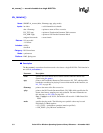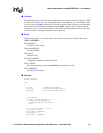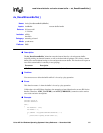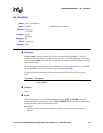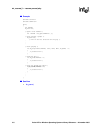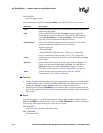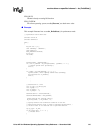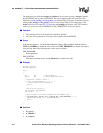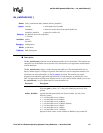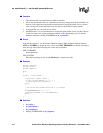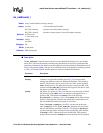
362 Voice API for Windows Operating Systems Library Reference — November 2003
dx_RxIottData( ) — receive data on a specified channel
TM_USRSTOP
Function stopped by user
Upon asynchronous completion of dx_RxIottData( ), the TDX_RXDATA event is posted.
!
!!
! Cautions
• Library level data is buffered when it is received. Applications can adjust the size of the buffers
to address buffering delay. The DXCH_RXDATABUFSIZE channel parameter can be used
with the dx_setparm( ) and dx_getparm( ) functions to adjust the buffer size.
• On Springware boards, dx_RxIottdata( ) will sometimes show an extra byte when receiving
data. At the application level, this extra byte can be discarded by looking at the total number of
bytes of data.
!
!!
! Errors
If the function returns -1, use the Standard Runtime Library (SRL) Standard Attribute function
ATDV_LASTERR( ) to obtain the error code or use ATDV_ERRMSGP( ) to obtain a descriptive
error message. One of the following error codes may be returned:
EDX_BADIOTT
Invalid DX_IOTT (pointer to I/O transfer table)
EDX_BADPARM
Invalid data mode
Parameter Description
chdev specifies the valid channel device handle obtained when the channel was
opened using dx_open( )
iottp points to the I/O Transfer Table. The iottp parameter specifies the
destination for the received data. This is the same DX_IOTT structure
used in dx_playiottdata( ) and dx_reciottdata( ). See DX_IOTT, on
page 509, for more information on this data structure.
lpTerminations points to the Termination Parameter Table Structure, DV_TPT, which
specifies termination conditions for the device handle.
Supported values are:
• DX_MAXTIME
• DX_MAXDATA (valid values are 1 - 65535 for tp_length field)
For more information on this structure, see DV_TPT, on page 485.
wType specifies the type of data to be received. To receive ADSI data, set wType
to DT_ADSI.
lpParams points to information specific to the data type specified in wType. The
format of the parameter block depends on wType. For ADSI data, set
lpParams to point to an ADSI_XFERSTRUC structure. For more
information on this structure, see ADSI_XFERSTRUC, on page 478.
mode specifies how the function should execute, either EV_ASYNC
(asynchronous) or EV_SYNC (synchronous)



